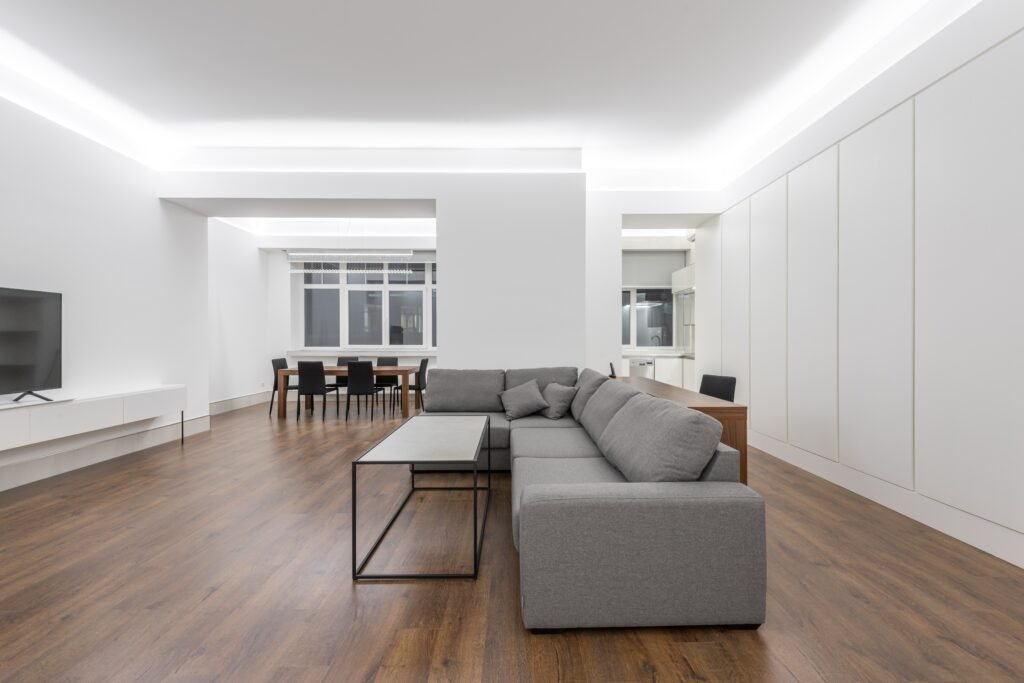How To Separate Foyer From Dining Room

Do you want to know how to separate foyer from dining room? Are you ready to transform your entrance area from an afterthought into a grand first impression? Separating the foyer and dining room is easy to achieve just that!
Whether you decide to go with a wall, sliding doors, or a unique partition system, deploying this design trick can instantly give your home more wow factor. I’ll share tips on picking the perfect division for these two integral parts of your house and helpful ideas about decoration and lighting that will truly showcase each space.
Understanding Your Space

Before we dive into different ways to separate the foyer from the dining room, let’s start by taking a closer look at your current layout. It’s essential to understand how your space is structured and take note of any elements that could affect the separation. Does your foyer open directly into the dining room? Are there any architectural features like columns, built-in furniture, or large windows that you need to consider?
Next, let’s get out the measuring tape. Knowing the exact dimensions of your foyer and dining room will help you decide which separation method is best. Measure both areas’ height, width, and length and jot these down. Doing this can avoid overcrowding and maintain a balanced and symmetrical look.
Remember, the key is to separate the two spaces without making either area feel cramped or neglected. So, pay close attention to the proportions of your space and the placement of your existing features.
7 Ideas On How To Separate Foyer From Dining Room

Now that you better understand your space, let’s explore seven creative ways to separate the foyer from the dining room. These options suit any budget and skill level, so don’t worry if you’re not an interior design expert!
① Furniture Placement

One of the simplest ways to separate the foyer from the dining room is by strategically placing your furniture. You don’t have to build a wall or install doors – sometimes, a well-placed bookcase or console table can do the trick!
For example, you could use a tall, open bookcase as a makeshift room divider. Not only does this help set a clear boundary between your foyer and dining room, but it also provides extra storage space. You can display your favorite books, family photos, or decorative items on the shelves.
Another idea is to use a console table. Place the table against the back of a sofa or along the edge of your dining room. You can decorate it with lamps, a flower vase, or other accessories to make it look appealing. This helps create a visual barrier without blocking light or making the space feel closed off.
Remember, this method works best when you consider the size and scale of your furniture and your room’s dimensions. Don’t forget to leave enough room for walking paths so your space remains functional.
② Partition Walls

Partition walls are another great way to create a distinct separation between your foyer and dining room. These are non-load-bearing walls, which means they don’t support any weight other than their own. They’re designed purely to divide spaces and can be constructed from various materials like wood, plasterboard, or glass.
One of the advantages of partition walls is their flexibility. You can customize them to match your home’s style and add features like shelves or a built-in fireplace. Plus, if you ever change your mind, partition walls are relatively easy to remove or modify.
For instance, a half-partition wall can give you the best of both worlds. It will provide a clear line of separation but still keep the overall area open and connected. If you opt for a glass partition wall, it will allow natural light to continue flowing through the two spaces while still offering a sense of division.
Remember, when planning for a partition wall, you should consider the wall material, the design, and the amount of light and visibility you prefer between the two areas. Also, ensure to check any local building codes or regulations before you start construction.
③ Curtains or Drapes
Curtains or drapes can also be an effective yet stylish way to separate your foyer from your dining room. These soft dividers are versatile and easy to install, adding a touch of elegance to any space. You can choose from various fabrics, colors, and patterns to match your home decor.
For example, floor-to-ceiling curtains can make a strong statement and completely separate the two areas. On the other hand, lighter, sheer curtains can create a soft divide, allowing light to filter through and maintaining a certain level of openness.
Besides, one of the advantages of using curtains or drapes is their flexibility. You can draw them back when you want to connect the foyer and dining room and let them loose when you require separation. This makes them a great option if your living space usage needs to change frequently.
Just remember to install a sturdy curtain rod that can handle the weight of the drapes. And make sure the length of the curtain is appropriate for your ceiling height.
④ Folding Screen or Panels

Folding screens or panels sometimes called a room divider, are yet another practical and stylish option to separate your foyer from the dining room. They come in myriad designs and materials, from wooden lattices to metal frameworks with fabric or paper inserts.
A folding screen is a freestanding piece of furniture that you can place directly where you want the separation to occur. They’re usually lightweight and easy to move, allowing you to change the room layout whenever you wish. This portability makes folding screens a great choice if you’re renting your home and can’t make permanent changes.
A wooden folding screen could be your best bet if you’re going for a more traditional look. It can add a touch of elegance and coziness to your space. On the other hand, if you prefer a contemporary style, consider a sleek screen made of metal and glass. This will maintain a modern, open feel while still delineating the two spaces.
⑤ Dividing With Area Rugs

Rugs are not merely decorative pieces but can serve as effective visual cues for separation. By defining areas with different rugs, you create a subconscious map for anyone entering the space.
For instance, you could place a warm, welcoming rug in your foyer and a more formal, intricate rug in the dining area. The contrast in designs communicates the separation of the two areas. This method is particularly effective in open-plan homes where physical barriers might disrupt the flow of the space.
It’s essential to choose rugs of appropriate size for each area. For your dining room, ensure the rug is large enough to accommodate all chairs, even when they’re pulled out. As for the foyer, a smaller rug that fits the width of the entryway would suffice. This differentiation in size further emphasizes the distinct purpose of each space.
Keep in mind the color and pattern of your rug, as well. Consider colors that compliment the overall decor of your space. A harmonious color palette can bring a sense of cohesiveness despite the spatial separation.
⑥ Make a Statement With Lights
Lighting is a powerful tool that can help you distinguish between your foyer and dining space. By tailoring the type, intensity, and style of lights in each area, you can create a visual boundary that separates the two spaces without needing physical dividers.
In your foyer space, you might want to consider a dramatic pendant light or a stylish chandelier. This provides necessary illumination and acts as a focal point, drawing attention as soon as you enter the house. Match it with a couple of smaller wall lights to spread the brightness evenly and create a warm, welcoming atmosphere.
As for your dining room, you could opt for a large, over-the-table light fixture. This creates a spotlight effect, highlighting the dining table and making it the clear center of attention in that space. You can add accent lights like small table lamps or candles for more intimate dinner parties.
Remember, the style of your light fixtures can also underline the separation. For instance, a modern, sleek lamp in the foyer contrasted with a vintage, rustic chandelier in the dining room underscores their different roles in the household.
It’s also important to consider the color temperature of the bulbs. A warmer glow in the formal dining room can create a cozy, relaxed environment, while a slightly cooler light in the foyer emphasizes the transition into the home.
Lastly, don’t forget about control. Having separate switches for the foyer and dining room lights reinforces the notion of two distinct areas. Even better, if you can install dimmer switches, you can adjust the atmosphere in each space depending on the time of day or occasion.
⑦ Dividing with Color

The choice of different paint colors, wallpaper designs, or wall decor for each area can create a clear visual boundary that neatly separates the two spaces.
In your foyer, consider brighter, more welcoming colors to create a cheerful first impression. You can even add a mirror to bounce the light around and make the space appear larger.
Contrastingly, in your dining room, you could opt for more subdued, warmer tones to create a cozy and intimate atmosphere for meals. A feature wall with a bold color or pattern can also act as a striking focal point, marking it as a separate space.
Remember, while the colors can differ, they should still complement each other to maintain a cohesive look throughout your home. Consider using an online color wheel or consulting with a professional to find color combinations that work well together.
Finally, pay attention to the transitions when using color to divide spaces. The point where the two colors meet should be clean and deliberate. Consider using a piece of furniture, like a bookshelf or cabinet, to provide a physical intersection between the two colors.
Decorating and Finalizing the Space

Decorating your newly separated spaces brings out their distinct characters. Make sure to choose decor that complements both areas and maintains their individuality. In the foyer, hang a mirror to make the space feel larger and brighter. You could also add a small bench or a shoe rack for practicality.
For the dining room, consider displaying some artwork or a beautiful chandelier that could be a conversation starter. Always remember that the decor should reflect the function of the space.
🏚 Complementing Both Areas
When choosing your decor, try to find a balance where both areas complement each other. This doesn’t mean everything has to match perfectly. Instead, search for elements that tie the two spaces together, like a consistent color scheme or similar patterns. This can create a harmonious flow between the foyer and the dining room, even though they’re separated.
🏚 Finalizing the Space
Once you’ve decorated your spaces, the next step is to finalize them. Start by thoroughly cleaning each area. This ensures that your decor stands out and the overall space looks tidy and inviting. Next, take a step back and look at your foyer and dining room from different angles.
If any furniture or decor feels out of place, feel free to rearrange it until everything feels just right. Remember, the goal is to make each space feel distinct yet connected, functional yet stylish.
Frequently Asked Questions
Q: How can I separate my open concept living room and family room?
Open-concept living and family rooms can be easily separated using strategic furniture placement. Consider positioning your living room furniture so that it defines the space. You can use coffee tables, sofas, or a large area rug to create a distinct living area.
Q: Can I have a music room as part of an open floor plan?
Yes, you can. You can use room dividers or develop visually distinct areas through lighting, color, and decor to create a separate room for your music endeavors within an open floor plan. Remember to consider sound insulation to benefit the rest of the household.
Q: How can I incorporate a home office into my living area?
Incorporating a home office into your living area can be achieved by creating a dedicated workspace. To minimize distractions, this could be a desk arranged against a wall or in a corner, away from the main living area. Make sure to choose decor and furniture that harmonize with the rest of the room.
Q: Is it possible to have a home theater with an open floor plan?
Absolutely! You can set up a home theater in an open floor plan by dedicating a specific wall for the screen and arranging seating to face it. For optimal viewing, the theater area should be located where natural light is minimal.
Q: Can my main entrance lead directly into my kitchen or laundry room?
While it’s not traditional, there’s no rule against having your main entrance lead into the kitchen or laundry room. However, consider creating a sense of separation between the entrance and these spaces for added privacy and organization.
Conclusion
All in all, understanding how to divide the dining room and foyer can seem like an overwhelming task. However, recognizing the key design elements and incorporating them into one’s overall aesthetic is a manageable feat. Remember that minimalism does not mean little thought has gone in — it means that careful consideration has been given to creating the perfect balance of comfort and appeal.
With this advice in mind, anyone can easily create a majestic space! For more tips on designing a functional and beautiful home interior, check out our blog for ideas and inspiration. Don’t forget: if you feel stuck during some steps of the process, there are always professionals waiting to help ensure your vision comes to life.






